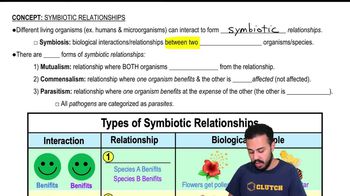The Opa gene is used to identify this endotoxin-producing bacterium that grows well in the high- CO₂ conditions inside phagocytes.
 Tortora 14th Edition
Tortora 14th Edition Ch. 14+15 - Principles of Disease and Epidemiology | Microbial Mechanisms of Pathogenicity
Ch. 14+15 - Principles of Disease and Epidemiology | Microbial Mechanisms of Pathogenicity Problem 15.2a
Problem 15.2aWhat is the LD₅₀ for the bacterial toxin tested in the following example? <IMAGE>
 Verified step by step guidance
Verified step by step guidance
Verified Solution
Key Concepts
LD₅₀
Bacterial Toxins

Dose-Response Relationship

Which of the following statements is true?
a. The primary goal of a pathogen is to kill its host.
b. Evolution selects for the most virulent pathogens.
c. A successful pathogen doesn't kill its host before it is transmitted.
d. A successful pathogen never kills its host.
Compare pathogenicity with virulence.
Which of the following is not a portal of entry for pathogens?
a. mucous membranes of the respiratory tract
b. mucous membranes of the digestive canal
c. skin
d. blood
e. parenteral route
Describe how hemolysins, leukocidins, coagulase, kinases, hyaluronidase, siderophores, and IgA proteases might contribute to pathogenicity.
Explain how drugs that bind each of the following would affect pathogenicity:
a. iron in the host's blood
b. N. gonorrhoeae fimbriae
c. S. pyogenes M protein